


Home » Judging Proportions in the Cairn Terrier
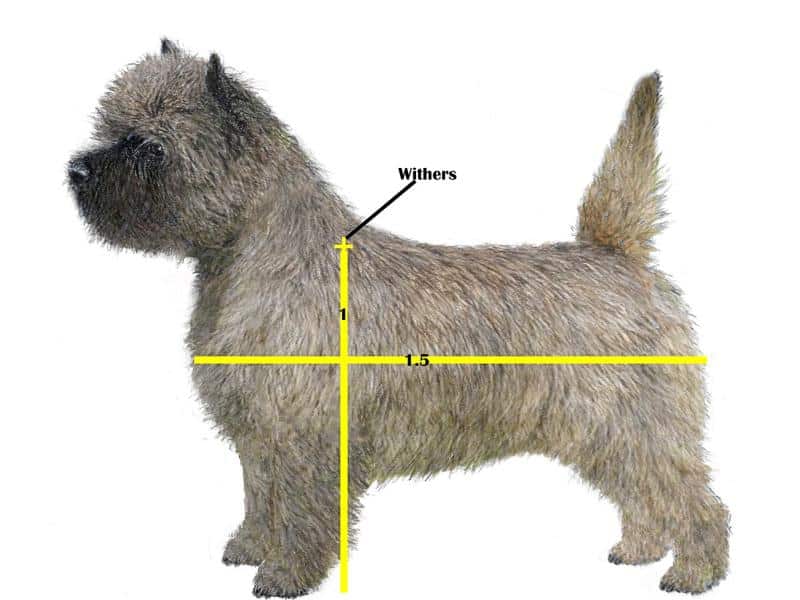
A correct Cairn Terrier is immediately identifiable by breed type, that is, the sum of qualities that distinguish this breed from any others. Whether seen up close or at a distance, a Cairn should be immediately recognized by correct breed type components.
The Cairn is a small, sturdy dog belonging to the “short-legged” terriers, but with unique proportions that should immediately differentiate it from what is not-Cairn. Even in silhouette, a Cairn should be recognizable.
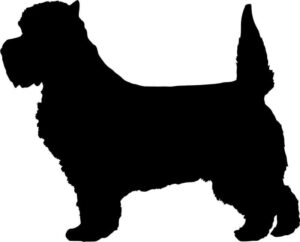
The traditional grooming of the Cairn coat is described as “tidying up” of a full, good double-coat, with plenty of head furnishings and hard hair covering the legs. While a healthy coat with dense, hard outer hair and soft undercoat is a hallmark of the breed, an astute judge should recognize that a skilled groomer can hide incorrect bone structure and proportions. A Cairn may be cleaned up for show, but excessive grooming is not consistent with breed type. A judge should have a trained eye to recognize correct proportions, even when the dog is expertly groomed.
The Cairn head is said to be the shortest and widest of the terriers, with a slight rounding of the skull between the ears. Viewed from the direct front, the perfectly proportioned Cairn head gives the impression of an equilateral triangle from the nose, through the eyes, and extending to the tips of small, pointed ears. The head is short in length, with a muzzle shorter than the skull and a definite stop. The muzzle-to-skull ratio is 4:5 seen from the side.
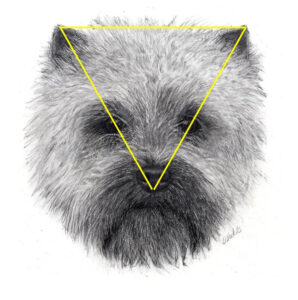
The balance of the nose, eyes, and ears gives distinctive expression that sets off the face of a Cairn. A narrow Cairn skull will not show an equilateral triangle. A poorly placed eye set will tend to fall outside the lines from the nose to the ear tips. Poor ear placement will result in a triangle that is too wide or too narrow at the top.
Cairns may be groomed to give the appearance of a rounded head profile from the front and a shorter muzzle from the side. Examination of a Cairn should include feeling the skull and the stop under the head furnishings. One method to appreciate head structure is to cup the head between the ears with the flat palm of the hand. A narrow skull will be felt even under highly groomed hair. The stop should be felt to see that it is well formed and definite. Judges should not be afraid to flatten any head furnishing during the table examination, to properly assess skull width and shape under the grooming.
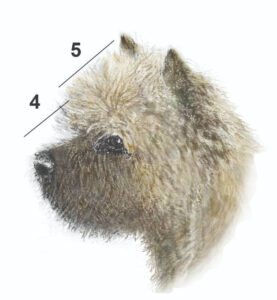
One method to appreciate head structure is to cup the head between the ears with the flat palm of the hand. A narrow skull will be felt even under highly groomed hair. The stop should be felt to see that it is well formed and definite. Judges should not be afraid to flatten any head furnishing during the table examination, to properly assess skull width and shape under the grooming.
Per the 1938 US Breed Standard, Cairns should weigh 13-14 pounds and measure 9.5-10 inches at the withers. The FCI Standard allows for 14-16 pounds and 11-12 inches. A massively oversized Cairn is not within keeping to either Standard, although not listed as a fault or disqualification.
Body length in a Cairn is measured from prosternum to point of buttocks. A correctly proportioned Cairn is 50 percent longer than the height at the withers. This means the Cairn body may be 14.5 to 15 inches in length per the CTCA Illustrated Standard. The overall shape is rectangular rather than square. A short or cobby back is incorrect. Per wording of the 1938 Standard, the back should be level and of medium length, the loin “strong,” and the tail “set on at back level” and carried gaily.
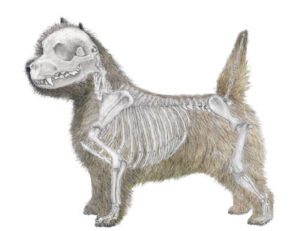
While Cairn legs are described as “medium” in length, the elbows should be level with the bottom of a “deep” chest and be at 50 percent of the body height at the withers. Cairn legs should form straight and strong columns in both front and back. Cairns do not have the short and curved leg assemblies found in the Scottish Terrier, their achondroplastic cousin.
Borrowing from breed-specific examination methods used for other terriers, I recommend “cupping” the prosternum and the buttocks to evaluate actual body length under the grooming. Sliding a hand gently from the shoulders, to the elbow, across the ribs, and under the chest will determine dimensions and leg length.
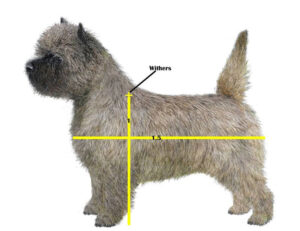
A Cairn should never be short-backed, square, or with great amounts of “daylight” under the body. A Cairn should not have the squarish profile found in the West Highland White Terrier. Body length in a Westie is measured on the back from the withers to the base of the tail, and is shorter than height in a correct Westie.
As stated in the CTCA Illustrated Standard, breeders and judges must keep the size, weight, and measurements of the Standard in mind in order to maintain correct type. While varied in size historically, balance and proportions must always be applied given the official Standard. A Cairn is not square, and should have a body one and one-half times his height. He is not delicate or refined. The Cairn is a rugged working terrier, of correct proportions to be able to charge down a tunnel, dispatch quarry, turn around, and escape the burrow, all with amazing dexterity and ferocity. It is recommended that when quality is even between two Cairns of differing size and proportions, a judge should reward the dog closer to the Breed Standard.
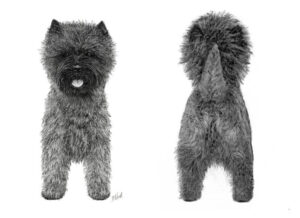
Disclaimer: The opinions expressed in this article are solely those of the author and do not express official views or opinions of the Cairn Terrier Club of America. The Cairn silhouette image was created for the author’s use. All other images are contained within the CTCA Illustrated Standard.